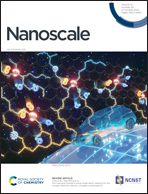Dissipative self-assembly of a proline catalyst for temporal regulation of the aldol reaction†
Abstract
The spatiotemporal regulation of chemical reactivity in biological systems permits a network of metabolic reactions to take place within the same cellular environment. The exquisite control of reactivity is often mediated by out-of-equilibrium structures that remain functional only as long as fuel is present to maintain the higher energy, active state. An important goal in supramolecular chemistry aims to develop functional, energy dissipating systems that approach the sophistication of biological machinery. The challenge is to create strategies that couple the energy consumption needed to promote a molecule to a higher energy, assembled state to a functional property such as catalytic activity. In this work, we demonstrated that the assembly of a spiropyran (SP) dipeptide (1) transiently promoted the proline-catalyzed aldol reaction in water when visible light was present as fuel. The transient catalytic activity emerged from 1 under light illumination due to the photoisomerization of the monomeric, O-protonated (1-MCH+) merocyanine form to the spiropyran (1-SP) state, which rapidly assembled into nanosheets capable of catalyzing the aldol reaction in water. When the light source was removed, thermal isomerization to the more stable MCH+ form caused the nanosheets to dissociate into a catalytically inactive, monomeric state. Under these conditions, the aldol reaction could be repeatedly activated and deactivated by switching the light source on and off.



 Please wait while we load your content...
Please wait while we load your content...